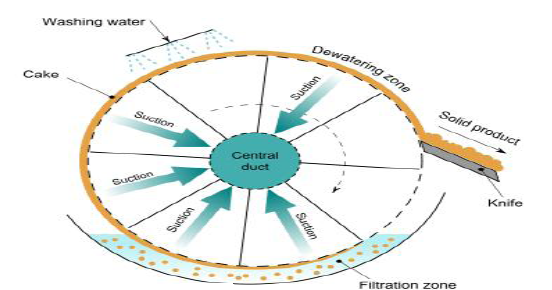





Published on Nov 30, 2023
Rotary drum vacuum filter is a very important tool for solid-liquid separation; it has various applications in the industrial field. The main advantage of this equipment is its relatively small space, low cost and easy to be maintained. All Rotary Vacuum Filters operate on a similar principle. A pressure differential between the surface and inside of the drum (or disc) is applied by means of vacuum.
This pressure differential cause's transport of liquid through the filtration surface while the filter medium arrests solid particles and a cake is formed. As the drum rotates, the cake rises above the slurry level in the filter tank and air is drawn through the cake, forcing out liquid. The liquid (filtrate) exits the filter through the internal piping and the vacuum head.
The drum is commonly divided into three zones:
*Cake building zone is operated under vacuum pressure.
*De-watering zone is operated under vacuum pressure.
*Cake removal zone is operated under high pressure.

The control head divides the filter drum into the different sections for filtration, washing, suction drying and cake discharge, so that in the course of one revolution each point of the drum area passes through these zones in succession.
The filtrate (clarified liquid) runs off through the separator receiver and is discharged by pumping.The filtered solid layer emerges from the suspension as the drum rotates, and following its emergence is washed (to remove impurities or to extract more product), suction-dried and discharged from the filter cloth. The wash liquid is fed onto the cake either directly by means of wash devices such as weirs or spray nozzles, or of a wash belt lying on top of the cake.
The filtrate from the wash zone can be drained off separately from the mother filtrate. The filter cake is discharged by means of a discharge device of some kind, which covers the entire drum and which is specially suited to the cake thickness, consistency and structure.
A multi-compartment drum type vacuum filter consists of a drum rotating about a horizontal axis, arranged so that the drum is partially submerged in the trough into which the material to be filtered is fed (slurry), Most drum filters are fed by operating the drum with about 35 percent of its circumference submerged in a slurry trough, although submergence can be set for any desired amount between zero and almost total.
All drum filters (except the single-compartment filter) utilize a rotary-valve arrangement in the drum-axis support trunnion to facilitate removal of filtrate and wash liquid and to allow introduction of air or gas for cake blowback if needed.
The valve controls the relative duration of each cycle as well as providing “dead” portions of the cycle through the use of bridge blocks. A typical valve design is shown below. Internal piping manifolds connect the valve with various sections of the drum